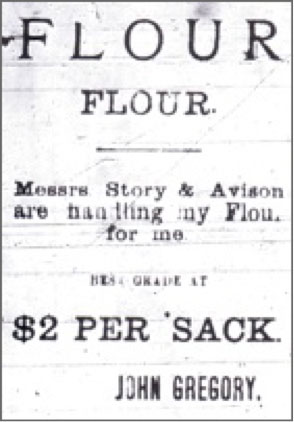In 1882, John D. Gregory, from Wingham, Ontario, came
to Manitoba and began scouting locations for a mill site. In 1883, he
took title and settled on NW 34-6-18, a farm that straddled the Souris
River about five miles upstream from were it now passes under Highway
#2 near Wawanesa. The site he chose was, technically, an ideal site for
a mill. The river in the Souris Bend area makes a rather sharp
descent (as local rivers go) onto the Assiniboine Plains allowing for a
considerable current. There were breaks in the valley walls on
each side of the river, allowing for cart trails, and hopefully, a rail
crossing. He built a mud dam to back the water up to ensure a steady
flow, erected an impressive stone mill building, set up the necessary
equipment and opened for business. At that time he was 40 km from the
rail line but he hoped that it would come to him, or he saw the
business as viable regardless.
In the mid eighties the mill was operating day and night. This prompted
expansion and improvements, notably the addition of a steam engine in
1885. At that time farmers were coming from a radius of 50
km.
Mr. Gregory, like other entrepreneurs who moved to southwestern
Manitoba in those times, was banking on the steady and enduring
economic growth of the area. His idea was right. His
location turned out to be wrong. In 1882, potential settlement
locations were, to an extent, judged on the availability of waterpower.
Then settlers realized that prairie rivers were somewhat seasonal and
unreliable as a source of water power, and second that steam power was
quickly becoming a more reliable, and in the long run, less expensive,
option.
And while Mr. Gregory adapted by adding steam power to his mill, his
location was not destined to be a population centre. The rail
lines passed to the north at Wawanesa and to the south at Boissevain.
Transportation quickly shifted from river and cart trail, to rail and
graded roads, and eventually to the automobile.
As it turned out it likely wasn’t just the lack of access to the export
market that sealed the fate of Gregory’s Mill. It was the
establishment of mills in the new population centres that sprang up
along the new railways that spelled the end.

The remains of the mill are easily overlooked today.
By the 1890’s, every new town on every new rail line was trying to
establish a mill and Wawanesa’s was opened in 1895. Mr. Gregory’s mill
closed without fanfare some time before that, an event unmarked in the
local press.
What was noted in the news was that Mr. Gregory was applying for a
“bonus” (think today’s financial incentives) to establish mills, first
in Wawanesa and later in Nesbit. He passed away on June 21, 1896 before
being able to establish himself in either of those locations.
On June 30, 1893 the Wawanesa Enterprise reported that:
“Mr. Gregory was in town Wednesday. He is ready to commence work on the
mill at Wawanesa as soon as the bonus by-law is carried. Several
members of the committee interviewed him, and he expressed himself as
perfectly satisfied with the prospects.”
Personal Life
While the story of Mr. Gregory is well documented, details of his
personal and family life have not survived. We know from contemporary
news articles that he was a vestryman in the Rounthwaite Anglican
Church in 1886, and that locals used his location as a picnic site, but
the local record of John Gregory’s life is almost always in reference
to the mill that was undoubtedly the focus of his life.

|





